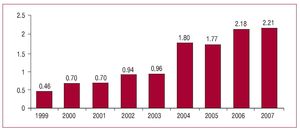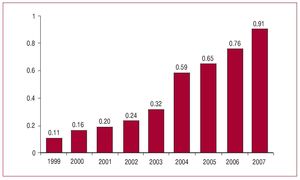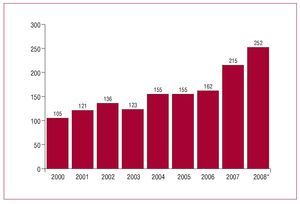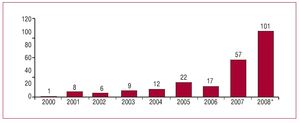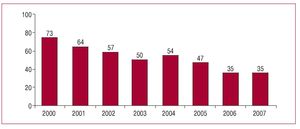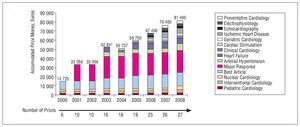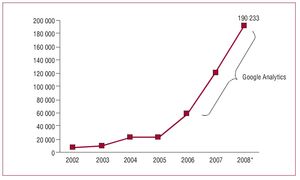The year 2008 has been both highly intense and stimulating for the editors of Revista Española de Cardiología. On the December "Editor's Page," we would like to share with all our readers the data on activity and dissemination obtained during the year, the most important bibliometric results, and our recent editorial concerns.1-3 The information we present here (including estimates for Sept-Dec 2008) was fully analyzed during the annual meeting of the Revista Española de Cardiología Editorial Committee at the Congress on Cardiovascular Diseases held in Bilbao in October. At the congress, a summary of the most important data was also presented at the Board of Directors Plenary Session and the Spanish Society of Cardiology (SEC) General Assembly.
Bibliometric Indices
In 2008, we have again improved our impact factor: 2.207 (Figure 1). We have managed to consolidate the substantial increase recently achieved in this popular bibliometric index and our journal is ranked among the most attractive international publications in the field of cardiovascular research. Currently, we find ourselves in the second quartile of the select club of cardiovascular journals chosen and indexed by the Institute for Scientific Information (ISI) in the latest issue of the Citation Reports. We are ranked 30th among the 74 most prestigious international cardiovascular journals included and analyzed in the Reports. Revista Española de Cardiología is the Spanish-language biomedical journal with the highest impact factor and in 2008 our leadership in the context of this well-known index has clearly been reinforced.
Figura 1. Time trend in the impact factor of Revista Española de Cardiología.
The number of citations received by articles published in our journal continues to grow. In 2007, Revista Española de Cardiología received 437 citations (in ISI-indexed journals) of most recent articles (published in 2005 and 2006). Moreover, the number of recent citations in other international, ISI-indexed journals (ie external citations) also continues to increase uninterruptedly. This year, we have received 180 external citations of articles published in 2005 and 2006. Although, as we have explained elsewhere,4 all journals published primarily in a language other than English must of necessity rely on a significant amount of self-citation, it is very gratifying to see that external citations contribute more and more to our increased impact factor. Even if we were to take the risk of being self-critical (something no journal would do) and only consider as valid external citations (the least favorable scenario), the evolution of this theoretical "external impact factor" would also depict very satisfactory progress (Figure 2). In fact, the final result of this theoretical external impact factor would vastly outreach the conventional impact factor (including all types of citation) achieved by most national, European cardiovascular journals. Moreover, we should also remember that our real impact in the scientific community is greater still as the ISI indexes few Spanish-language medical journals4 and, although citations in non-indexed journals are ignored when evaluating the impact factor, they do decisively influence the dissemination of scientific content.
Figure 2. Time trend in a theoretical "external" impact factor that only counts as valid citations received from other journals.
In turn, according to ISI data, "total" citations received (of both more and less recent articles) also increased in 2007, reaching 1195 (53% external citations). This confirms the continued interest over time that Revista Española de Cardiología articles arouse (mean citations-received life is 3.7 years). Finally, the immediacy index (ie citations received in 2007 of articles published in 2007) is 0.619, a substantial improvement on last year, putting us in an attractive 22nd place among the 74 ISI-evaluated journals.
All this confirms the maturity both of Revista Española de Cardiología in particular and of cardiovascular research conducted in Spain in general. Increasingly, our articles are cited in other publications, guaranteeing our influence in the ever more globalized scientific process of cardiovascular research. Until quite recently, many researchers considered citing Revista Española de Cardiología in new national or international publications might be against their best interests. Nothing could be further from the truth because, at the end of the day, the correct approach is simply to cite articles on the basis of their scientific relevance alone. Fortunately, little by little, we have managed to overcome many old prejudices and "scientific complexes" and, currently, can proudly cite the research papers published in our journal with the guarantee that they are of excellent scientific quality. This continuous process of maturing will condition the greater international dissemination of the best cardiovascular research conducted in Spain. As we have stressed on these pages and on other occasions,4 in this way we all benefit, more and more, from the "circle of prestige," attracting more and better research papers to our pages, which enables us to be ever more selective and further improve content quality and scientific impact.
Articles Received and Manuscript Management
In 2008, the total number of manuscripts sent to our journal (632) has grown (by 13.2%). The number of Original Articles has also increased (total=252; 17% up on 2007) (Figure 3). Thus, we confirm the growing attraction of our publication for all researchers in the cardiovascular field. We have also seen growth in the number of manuscripts received from outside of Spain. The substantial contribution from Argentina has stabilized (16 manuscripts) and we have increased the number of manuscripts received from Mexico, Colombia, and Chile (24). Special mention should be made of countries like Italy and Poland, with a growing contribution (13). Moreover, we have encountered exponential growth in the number of manuscripts received in English (total=101; 77% up on 2007) (Figure 4).
Figure 3. Time trend in the number of Original Articles received. *Data for 2008 include an estimate for Sept-Dec.
Figure 4. Exponential growth in the number of manuscripts submitted directly in English. *Data for 2008 include an estimate for Sept-Dec.
Currently all papers are sent for review via the electronic manuscript management system introduced for the first time in Spain in February 2006 (available at: www.revespcardiol.org).5 The incorporation of this powerful editorial tool (Editorial Manager-Elsevier Editorial System) represented a clear bid for quality and has completely transformed the editorial process and our secretariat in the Casa del Corazón offices. We can now compete on equal terms with the prestigious international journals that already offered this. As expected, the incorporation of this system has been well received by authors and reviewers. Thus, the ease of submitting manuscripts has generated a "call effect" explaining, at least partly, the increased number of manuscripts received. It also facilitates manuscript review from anywhere in the world and offers direct access to the most powerful search engines (SCOPUS). Without doubt, as we will now see, this has contributed to improved editorial times. However, we would like to remind reviewers of the importance of accepting all the invitations they receive in their e-mail and continuing to conduct reviews with the utmost diligence.
Reviews and Publication
Prior to September 2008, Revista Española de Cardiología Editorial Committee members and referees had carried out a total of 631 reviews of manuscripts. During the same period, 164 reviews have been requested from our experts in methodology and biostatistics. These figures only cover first reviews; if we consider that many articles are sent for a second review, we can picture the intense activity the peer review process involves during the year. Review times for Original Articles and Brief Reports have improved by comparison with 2007 (mean, 18.4 [13.1] vs 20.2 [14.7] days). Moreover, total publication time (time of acceptance + time of acceptance-publication) has also improved substantially (279 vs 309 days in 2007). By comparison, total publication times of the European Heart Journal and the Journal of the American College of Cardiology during the first 6 months of 2008 were 267 and 237 days, respectively.
In 2008, we are very pleased to have achieved 3 apparently modest but for us very important, editorial objectives. To do so, we needed to revise our internal and editorial work process. Firstly, we have managed to publish the paper edition of the journal within the first 3 days of each month. Previously, this was released in the second week of each month and reached readers' homes even later. Secondly, we have systematized preliminary publication of articles prior to their definitive publication in print (advanced online publication), thus achieving more reasonable times for our electronic Spanish-language edition. Thirdly, and perhaps most importantly, for the first time we have managed to make the initial English translation of contents available via the electronic English-language edition (and PubMed) in the same month as its publication. This is of transcendental importance in dynamizing the dissemination of contents. Thus, English-language readers interested in our new articles need not feel frustrated by having to wait months before they can read them. Obviously, initial translations are automatically replaced by definitive PDF files following revision by authors and copy editors, guaranteeing top quality throughout the process.
The increased number of manuscripts received, together with ever more critical reviews, obliges us to progressively reduce the final acceptance rate (Figure 5). This, and the fact that a growing number of manuscripts need to be reviewed directly in English has meant a veritable overload for all our referees. However, their reviews are essential to the scientific process and provide an inestimable aid when making the final decision on acceptance for publication. It is very important to highlight the fact that external Editorial Committee collaborators assume a growing responsibility in our peer-review process (30% of reviews in 2005, 50% in 2008). Table 1 lists the collaborators who disinterestedly reviewed papers in 2008. We wish to express our most sincere thanks to all of them. To stimulate the review process, we have designed various initiatives. The first has been to offer all referees "continuing education credits," awarded directly by the Accreditation Committee of the SEC Continuing Education Committee. This year, we awarded these credits for the first time and sent recipients the corresponding certificates. Furthermore, like other journals,6 we have created the figure of "Elite Referee" (Table 2) and awarded the corresponding diploma accreditation in acknowledgement of the excellence of these reviewers' work. Excellence in these reviews is calculated by scoring 3 parameters: a) review quality; b) number of reviews; and c) time required to finalize them. These certificates were awarded at the last meeting of the Congress of Cardiovascular Disease in Bilbao when, moreover, an interesting debate took place on the convenience of updating and renewing Editorial Committee members.
Figure 5. Percentage of original articles accepted.
Prizes Awarded for Articles Published
All SEC Scientific Sections award a prize to the best article published by Revista Española de Cardiología in their particular area (Table 3 and Figure 6). This year, we managed to increase the number of prizes and their value (27 prizes; 81 400 Euros). These prizes constitute a stimulus for the best research papers published in our journal. We would like to thank the Scientific Sections and the SEC Board for supporting this initiative, aimed at stimulating the process of developing and publishing quality research.
Figure. 6. Time trend in the prizes awarded for the best articles published in Revista Española de Cardiología.
Supplements, Special Issues, and Special Articles
Following the increased number of supplements in recent years,1-3,7 in 2008 we have slightly reduced these (total=6). However, we have taken special care in selecting topics in an effort to optimize the quality, attraction, and dissemination of these articles (color-printing, open access from the journal website) and, simultaneously, favor their function in continuing education. Although all the supplements require sponsorship, many are currently generated at the initiative of the SEC Scientific Sections themselves.
In the special issue on "Current Topics in Cardiology," the Scientific Sections also participate with a review article summarizing the most important advances in their respective fields.8 This indexed issue enables readers to review, in a reasonable amount of time, the latest international and national scientific discoveries, and disseminates up-to-date data from SEC registries and the prize-winning articles.
With the publication of different Special Articles (13 in 2008), the journal has also collaborated in disseminating the latest major clinical trial results,9-13 official Scientific Section activity registries,14-18 and European Society of Cardiology clinical practice guidelines, published in electronic format only.19-23
Dissemination
Currently, electronic editions constitute the best means of disseminating biomedical journals. Moreover, to achieve maximum dissemination, at Revista Española de Cardiología we have always defended the idea of eliminating all barriers to possible readers (accepting negative economic implications to do so). Our full-text contents are freely available via the most important bibliographic databases and directly from our full-text English edition. New IT tools (Google Analytics) facilitate precise data on visits and PDF downloads generated. This year, website visits (www.revespcardiol.org) have increased substantially in Spanish (1 797 483; data for 2008 include an estimate for Sept-Dec) and English (Figure 7). Moreover, the number of PDF downloads of full-text articles (estimated total 490 176 in Spanish and 82 626 in English) has grown far beyond our expectations.1-3
Figure 7. Time trend for visits to the English-language website of Revista Española de Cardiología. *Data for 2008 include an estimate for Sept-Dec.
Editorial Considerations
The editors continue to strive to achieve editorial excellence improving the quality of our scientific contents and stimulating maximum international dissemination.1-3 During recent years we have participated in various editorial initiatives to increase the recognition and dissemination of our journal. In 2008, we distributed a questionnaire on the status of all SEC-affiliated journals. Our aim is to facilitate electronic links with these publications and thus benefit from greater dissemination and receive articles for review. At the last Editorial Committee meeting, we had the pleasure of hearing from a guest speaker, the new Editor of the European Heart Journal (Dr Thomas F. Lüscher) and sharing our editorial concerns with him. Moreover, optimizing article publication and into-English translation times has meant that in 2008, for the first time, we have been able to accompany many Original Articles with Editorials written by prestigious, internationally-recognized experts (11 such Editorials). On the other hand, after several years participating in regular meetings of the HEART group (of cardiovascular journal editors), this year we have jointly published a brief consensus document on editorial policy agreements.24 In parallel, at Revista Española de Cardiología, we have led the preparation of a much more detailed paper on all the aspects of editorial policy we have always defended. This document,25 has been widely disseminated and published jointly, and practically simultaneously, by 33 national, European Society of Cardiology cardiovascular journals. Finally, this year we have been nominated to coordinate the European Society of Cardiology "Editors' Club" (an official, national cardiovascular journals work group). We are convinced that all these editorial initiatives contribute to an even greater increase in the dissemination, credibility and international prestige of our publication.
Correspondence: Revista Española de Cardiología. Sociedad Española de Cardiología.
Nuestra Señora de Guadalupe, 5-7. 28028 Madrid. España.
E-mail: rec@revespcardiol.org
